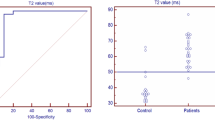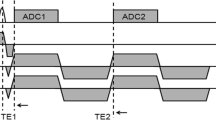Abstract
Objectives
Our aim was to investigate the role of age, sex, and location on MR T2* values of the knee cartilage in asymptomatic controls and patients with osteoarthritis (OA).
Methods
A total of 100 participants, including 40 with OA and 60 asymptomatic controls, were enrolled in this study. Patients with OA were compared to age- (≥ 41 years old) and sex-matched controls. Controls were divided by age (aged 21–40 years, 41–60, ≥ 61). T2* values were acquired using a T2*-weighted fast gradient-echo sequence and a 1.5-T MRI scanner. T2* values of the femoral and tibial cartilages at the weight-bearing areas were obtained for comparisons.
Results
The T2* values significantly increased with age and were significantly higher in the medial femoral cartilage (35.96 ± 4.06 and 31.85 ± 2.44 ms), medial tibial cartilage (30.95 ± 2.87 and 28.24 ± 1.74 ms), and lateral femoral cartilage (33.90 ± 3.15 and 31.51 ± 2.28 ms) in OA patients versus age- and sex-matched controls. Among OA patients, the T2* values for women exceed those in men in the medial femoral cartilage (37.59 ± 4.43 and 34.16 ± 2.63 ms) and medial tibial cartilage (32.17 ± 2.59 and 29.62 ± 2.53 ms; p < 0.01). Correlations were found between the Lequesne index and the T2* values for the medial femoral cartilage (r = 0.636, p < 0.001) and the medial tibial cartilage (r = 0.433, p = 0.005).
Conclusion
Cartilage T2* values tend to increase with age and are useful in assessing cartilage degeneration in early OA.
Key Points
• Age, sex, and location have important effects on cartilage T2* values at the knee.
• MR T2* measurements are useful toward assessing cartilage degeneration.
• The medial femoral and tibial cartilage T2* values correlate well with disease severity.




Similar content being viewed by others
Abbreviations
- GRE:
-
Gradient-recalled echo
- MR:
-
Magnetic resonance
- OA:
-
Osteoarthritis
- ROI:
-
Region of interest
- TF:
-
Tibiofemoral
References
Andreisek G, White LM, Yang Y, Robinson E, Cheng HL, Sussman MS (2009) Delayed gadolinium-enhanced MR imaging of articular cartilage: three-dimensional T1 mapping with variable flip angles and B1 correction. Radiology 253:865–873
Huang GS, Lee HS, Chou MC et al (2010) Quantitative MR T2 measurement of articular cartilage to assess the treatment effect of intra-articular hyaluronic acid injection on experimental osteoarthritis induced by ACLX. Osteoarthritis Cartilage 18:54–60
van Tiel J, Kotek G, Reijman M et al (2016) Is T1ρ mapping an alternative to delayed gadolinium-enhanced MR imaging of cartilage in the assessment of sulphated glycosaminoglycan content in human osteoarthritic knees? An in vivo validation study. Radiology 279:523–531
Koff MF, Amrami KK, Kaufman KR (2007) Clinical evaluation of T2 values of patellar cartilage in patients with osteoarthritis. Osteoarthritis Cartilage 15:198–204
Dunn TC, Lu Y, Jin H, Ries MD, Majumdar S (2004) T2 relaxation time of cartilage at MR imaging: comparison with severity of knee osteoarthritis. Radiology 232:592–598
Bittersohl B, Hosalkar HS, Miese FR et al (2015) Zonal T2* and T1Gd assessment of knee joint cartilage in various histological grades of cartilage degeneration: an observational in vitro study. BMJ Open e006895:5. https://doi.org/10.1136/bmjopen-002014-006895
Newbould RD, Miller SR, Toms LD et al (2012) T2* measurement of the knee articular cartilage in osteoarthritis at 3T. J Magn Reson Imaging 35:1442–1429
Bittersohl B, Hosalkar HS, Hughes T et al (2009) Feasibility of T2* mapping for the evaluation of hip joint cartilage at 1.5T using a three-dimensional (3D), gradient-echo (GRE) sequence: a prospective study. Magn Reson Med 62:896–901
Mamisch TC, Hughes T, Mosher TJ et al (2012) T2 star relaxation times for assessment of articular cartilage at 3T: a feasibility study. Skeletal Radiol 41:287–292
Marik W, Apprich S, Welsch GH, Mamisch TC, Trattnig S (2012) Biochemical evaluation of articular cartilage in patients with osteochondrosis dissecans by means of quantitative T2- and T2*-mapping at 3 T MRI: a feasibility study. Eur J Radiol 81:923–927
Smith HE, Mosher TJ, Daradzinski BJ et al (2001) Spatial variation in cartilage T2 of the knee. J Magn Reson Imaging 14:50–55
Stahl R, Blumenkrantz G, Carballido-Gamio J et al (2007) MRI-derived T2 relaxation times and cartilage morphometry of the tibio-femoral joint in subjects with and without osteoarthritis during a 1-year follow-up. Osteoarthritis Cartilage 15:1225–1234
Loeser RF (2009) Aging and osteoarthritis: the role of chondrocyte senescence and aging changes in the cartilage matrix. Osteoarthritis Cartilage 17:971–979
Larbre JP, Da Silva JA, Moore AR, James IT, Scott DL, Willoughby DA (1994) Cartilage contribution to gender differences in joint disease progression. A study with rat articular cartilage. Clin Exp Rheumatol 12:401–408
Lange AK, Fiatarone Singh MA, Smith RM et al (2007) Degenerative meniscus tears and mobility impairment in women with knee osteoarthritis. Osteoarthritis Cartilage 15:701–708
Inoue K, Hukuda S, Fardellon P et al (2001) Prevalence of large-joint osteoarthritis in Asian and Caucasian skeletal populations. Rheumatology (Oxford) 40:70–73
Neogi T, Zhang Y (2013) Epidemiology of osteoarthritis. Rheum Dis Clin North Am 39:1–19. https://doi.org/10.1016/j.rdc.2012.1010.1004
Bittersohl B, Hosalkar HS, Sondern M et al (2014) Spectrum of T2* values in knee joint cartilage at 3 T: a cross-sectional analysis in asymptomatic young adult volunteers. Skeletal Radiol 43:443–452
Grotle M, Hagen KB, Natvig B, Dahl FA, Kvien TK (2008) Obesity and osteoarthritis in knee, hip and/or hand: an epidemiological study in the general population with 10 years follow-up. BMC Musculoskelet Disord 9. https://doi.org/10.1186/1471-2474-1189-1132
Dawson J, Linsell L, Doll H et al (2005) Assessment of the Lequesne index of severity for osteoarthritis of the hip in an elderly population. Osteoarthritis Cartilage 13:854–860
Stroller DW, Martin C, Crues JV 3rd, Kaplan L, Mink JH (1987) Meniscal tears: pathologic correlation with MR imaging. Radiology 163:731–738
Altman R, Asch E, Bloch D et al (1986) Development of criteria for the classification and reporting of osteoarthritis. Classification of osteoarthritis of the knee. Diagnostic and Therapeutic Criteria Committee of the American Rheumatism Association. Arthritis Rheum 29:1039–1049
Zhang W, Doherty M, Peat G et al (2010) EULAR evidence-based recommendations for the diagnosis of knee osteoarthritis. Ann Rheum Dis 69:483–489
Luyten FP, Denti M, Filardo G, Kon E, Engebretsen L (2012) Definition and classification of early osteoarthritis of the knee. Knee Surg Sports Traumatol Arthrosc 20:401–406
Messent EA, Ward RJ, Tonkin CJ, Buckland-Wright C (2005) Cancellous bone differences between knees with early, definite and advanced joint space loss; a comparative quantitative macroradiographic study. Osteoarthritis Cartilage 13:39–47
Kellgren JH, Lawrence JS (1957) Radiological assessment of osteo-arthrosis. Ann Rheum Dis 16:494–502
Heidari B (2011) Knee osteoarthritis prevalence, risk factors, pathogenesis and features: part I. Caspian J Intern Med 2:205–212
Colebatch AN, Hart DJ, Zhai G, Williams FM, Spector TD, Arden NK (2009) Effective measurement of knee alignment using AP knee radiographs. Knee 16:42–45
Bydder M, Rahal A, Fullerton GD, Byder GM (2007) The magic angle effect: a source of artifact, determinant of image contrast, and technique for imaging. J Magn Reson Imaging 25:290–300
Chiang SW, Tsai PH, Chang YC et al (2013) T2 values of posterior horns of knee menisci in asymptomatic subjects. PLoS One 8:e59769
Miller AJ, Joseph PM (1993) The use of power images to perform quantitative analysis on low SNR MR images. Magn Reson Imaging 11:1051–1056
Storey JD (2002) A direct approach to false discovery rates. J R Stat Soc Series B Stat Methodol 64:479–498
Mosher TJ, Liu Y, Yang QX et al (2004) Age dependency of cartilage magnetic resonance imaging T2 relaxation times in asymptomatic women. Arthritis Rheum 50:2820–2828
Mosher TJ, Dardzinski BJ, Smith MB (2000) Human articular cartilage: influence ofaging and early symptomatic degeneration on the spatial variation of T2—preliminary findings at 3 T. Radiology 214:259–266
Chou MC, Tsai PH, Huang GS et al (2009) Correlation between the MR T2 value at 4.7 T and relative water content in articular cartilage in experimental osteoarthritis induced by ACL transection. Osteoarthritis Cartilage 17:441–447
Bittersohl B, Miese FR, Hosalkar HS et al (2012) T2* mapping of hip joint cartilage in various histological grades of degeneration. Osteoarthritis Cartilage 20:653–660
O’Connor MI (2007) Sex difference in osteoarthritis of the hip and knee. J Am Acad Orthop Surg 15:S22–S25
Srikanth VK, Fryer JL, Zhai G, Winzenberg TM, Hosmer D, Jones G (2005) A meta-analysis of sex differences prevalence, incidence and severity of osteoarthritis. Osteoarthritis Cartilage 13:769–781
Mosher TJ, Collins CM, Smith HE et al (2004) Effect of gender on in vivo cartilage magnetic resonance imaging T2 mapping. J Magn Reson Imaging 19:323–328
Eckstein F, Collins JE, Nevitt MC et al (2015) Brief report: cartilage thickness change as an imaging biomarker of knee osteoarthritis progression: data from the Foundation for the National Institutes of Health Osteoarthritis Biomarkers Consortium. Arthritis Rheumatol 67:3184–3189
Qian Y, William AA, Chu CR, Boada FE (2010) Multicomponent T2* mapping of knee cartilage: technical feasibility ex vivo. Magn Reson Med 64:1427–1432
Funding
This study was funded by grant (no. 104SWF-08) at Taipei Medical University Wan Fang Hospital Inter-institute Research Project and grant (no. MOST102-2221-E-038-009-) at Ministry of Science and Technology, Taiwan.
Author information
Authors and Affiliations
Corresponding author
Ethics declarations
Guarantor
The scientific guarantor of this publication is Professor Wing P. Chan.
Conflict of interest
The authors of this manuscript declare no relationships with any companies whose products or services may be related to the subject matter of the article.
Statistics and biometry
No complex statistical methods were necessary for this paper.
Informed consent
All subjects signed the study informed consent form for normal subjects.
Written informed consent was waived by the Institutional Review Board for OA patients.
Ethical approval
Institutional Review Board approval was obtained.
Methodology
• Prospective (normal subjects)/retrospective (OA patients)
• Observational
• Performed at one institution
Rights and permissions
About this article
Cite this article
Tsai, PH., Wong, CC., Chan, W.P. et al. The value of MR T2* measurements in normal and osteoarthritic knee cartilage: effects of age, sex, and location. Eur Radiol 29, 4514–4522 (2019). https://doi.org/10.1007/s00330-018-5826-z
Received:
Revised:
Accepted:
Published:
Issue Date:
DOI: https://doi.org/10.1007/s00330-018-5826-z




